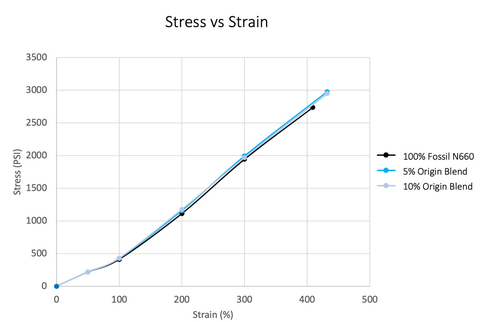Origin Materials’ Sustainable Carbon Black Blends Meet or Exceed Fossil-Based N660 Performance for Tires and Mechanical Rubber Goods
Origin Materials has achieved significant milestones by producing carbon black blends that meet or exceed the N660 performance specification, commonly used in automotive tires and mechanical rubber goods. This breakthrough positions Origin's sustainable, bio-based carbon black as a viable alternative to traditional fossil-based options, particularly in a market facing supply shortages. The blends demonstrate comparable or enhanced performance while being free from polycyclic aromatic hydrocarbons (PAHs). Given the automotive industry's push towards sustainability, Origin's technology could meet burgeoning demand effectively, projecting strong market potential.
- Origin's sustainable carbon black blends meet/exceed N660 specification.
- Potential for widespread adoption in a growing carbon black market.
- No detectable levels of PAH in carbon black, enhancing safety appeal.
- Blends outperform fossil-based options in performance metrics.
- None.
Bench-scale results validate Origin’s carbon black as high-performance bio-based tire filler which can be blended into mechanical rubber goods and automotive applications

Figure 1 Rubber compounds containing up to
The bench-scale achievement validates the potential for Origin’s sustainable, bio-based, low-carbon carbon black to be used broadly in the large, rapidly growing global carbon black market. The N660 specification represents a “gold standard” which Origin’s blended product has achieved, indicating the potential for widespread adoption of Origin’s carbon black not only in N660 applications, but in less technically demanding specifications, as well.
The materials are expected to be highly sought-after within the global carbon black market, which is experiencing a supply shortage and in need of sustainable alternatives to petroleum-based carbon black, in particular for the automotive industry which has made extensive sustainability and net zero commitments.
For tire applications, Origin’s sustainable carbon black is expected to be an attractive alternative to reclaimed carbon black since it does not suffer the same performance limitations as reclaimed carbon black and can even exceed the performance of fossil-based materials. Origin’s carbon black could help tire manufacturers develop sustainable high-performance products that go beyond the constraints of reclaimed carbon black, which is typically added into fossil carbon black as a 5
The achievement demonstrates the flexibility and transformative potential of Origin’s patented technology platform, which can turn the carbon found in sustainable wood residues into useful materials while capturing carbon in the process. In addition to sustainability and performance advantages, Origin’s carbon black contains no detectable levels of PAH (polycyclic aromatic hydrocarbons).
“We have made several carbon black blends that meet or exceed the performance of N660, a highly technical carbon black specification, and we look forward to further increasing the proportion of our material in similar blends in the future in a stepwise fashion, typical of carbon black development programs for tires and other applications,” said Origin Materials Co-Founder and Co-CEO
Technical Overview
With support from
In addition, the study found that, compared with
The results demonstrate the suitability of Origin’s carbon black as a bio-based, low-carbon emission filler for diverse applications including the high-performance N660 specification, suggesting broad potential for use in other specifications and applications, as well.
Origin’s carbon black is made by treating HTC (hydrothermal carbon), a unique material produced from Origin’s core process and which forms from the interaction of lignin and CMF (chloromethyl furfural) during the conversion of the biomass. Origin’s HTC can be tuned to achieve custom performance criteria, including for carbon black, by controlling process conditions and post-processing. Carbon black derived from Origin’s HTC is physically similar to fossil-based carbon black, with primary particles clustered into “grapelike” aggregates with complex structure (Figure 2). Compared with fossil-based carbon black, Origin’s carbon black offers an enhanced ability to manipulate surface chemistry and morphology, making it a particularly versatile material in addition to offering sustainability and performance benefits.
Origin is committed to addressing the most pressing sustainability and performance challenges in the carbon black industry, enabling net zero goals across mechanical rubber goods, automotive, and other applications. For more information, visit https://www.originmaterials.com/products/carbon-black.
About
Headquartered in
For more information, visit www.originmaterials.com.
Cautionary Note on Forward-Looking Statements
This press release contains certain forward-looking statements within the meaning of the federal securities laws. Forward-looking statements generally are accompanied by words such as “believe,” “may,” “will,” “estimate,” “continue,” “anticipate,” “intend,” “expect,” “should,” “would,” “plan,” “predict,” “potential,” “seem,” “seek,” “future,” “outlook,” and similar expressions that predict or indicate future events or trends or that are not statements of historical matters. These forward-looking statements include, but are not limited to, statements regarding Origin Materials’ business strategy, estimated total addressable market, access to traditional financing sources, budget and timelines to complete Origin 1 and Origin 2, ability to convert capacity reservations and offtake agreements into revenue, ability to enter new end-markets, ability to develop new product categories, commercial and operating plans, product development plans, anticipated growth and projected financial information and ability to realize the anticipated benefits, performance, or rates of adoption of Origin’s carbon black discussed in the press release. These statements are based on various assumptions, whether or not identified in this press release, and on the current expectations of the management of
View source version on businesswire.com: https://www.businesswire.com/news/home/20230330005206/en/
Investors: ir@originmaterials.com
Media: media@originmaterials.com
Source:
FAQ
What recent achievement has Origin Materials announced?
How does Origin's carbon black compare to traditional fossil-based carbon black?
What is the significance of the N660 specification in the carbon black market?
What are the benefits of using Origin's carbon black for automotive applications?






